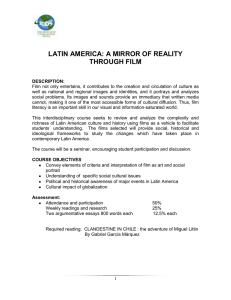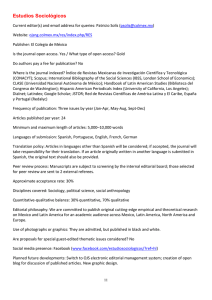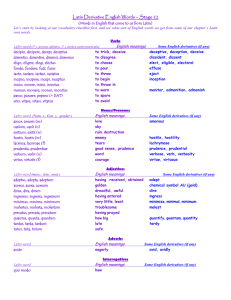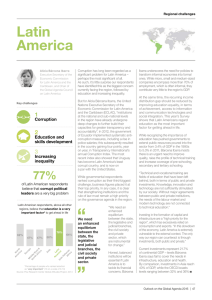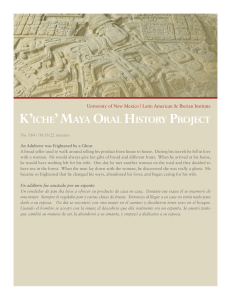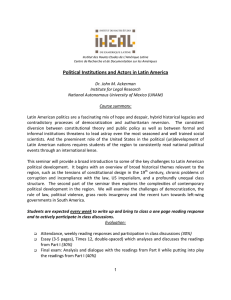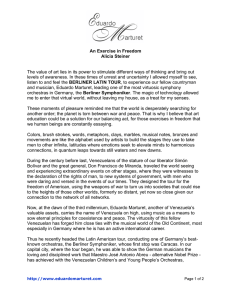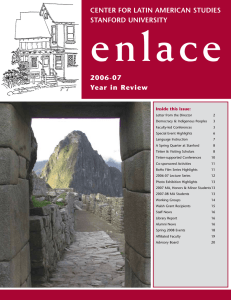Relations Between Latin America and the United States
Anuncio
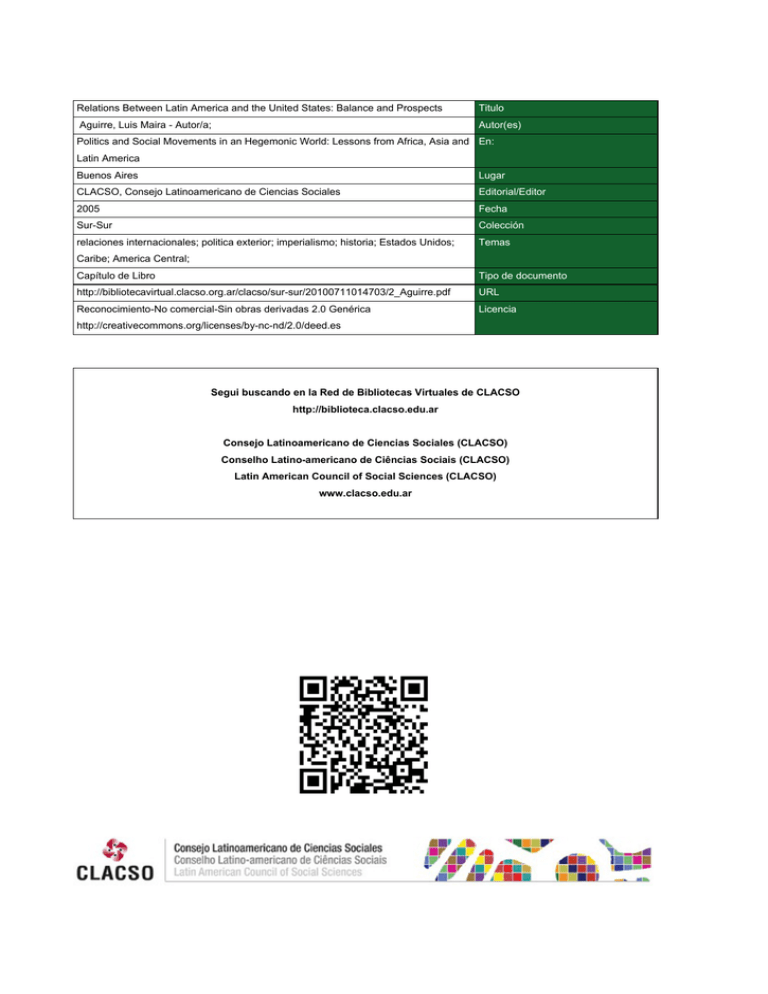
Relations Between Latin America and the United States: Balance and Prospects Titulo Aguirre, Luis Maira - Autor/a; Autor(es) Politics and Social Movements in an Hegemonic World: Lessons from Africa, Asia and En: Latin America Buenos Aires Lugar CLACSO, Consejo Latinoamericano de Ciencias Sociales Editorial/Editor 2005 Fecha Sur-Sur Colección relaciones internacionales; politica exterior; imperialismo; historia; Estados Unidos; Temas Caribe; America Central; Capítulo de Libro Tipo de documento http://bibliotecavirtual.clacso.org.ar/clacso/sur-sur/20100711014703/2_Aguirre.pdf URL Reconocimiento-No comercial-Sin obras derivadas 2.0 Genérica Licencia http://creativecommons.org/licenses/by-nc-nd/2.0/deed.es Segui buscando en la Red de Bibliotecas Virtuales de CLACSO http://biblioteca.clacso.edu.ar Consejo Latinoamericano de Ciencias Sociales (CLACSO) Conselho Latino-americano de Ciências Sociais (CLACSO) Latin American Council of Social Sciences (CLACSO) www.clacso.edu.ar Luis Maira Aguirre* Relations Between Latin America and the United States: Balance and Prospects** The Caribbean and Central America at the origin of the United States imperial expansion If the relations between the United States and Latin America are studied from a historical perspective, they appear to be considerably more stable and to have greater continuity than is suggested by an examination based on specific circumstances. Since the Latin American countries consolidated their independence from the Spanish Empire in the second and third decades of the nineteenth century, their links with the leading country in the north of the hemisphere have been asymmetrical, dependent and of secondary importance for policymakers in Washington. Exceptions to this are only found under certain “crisis situations” that quite occasionally take place in Latin American countries. The rest of the time, a routine course prevails in which decisions are left to middle rank officials at the State Department who handles the situations faced by the diverse governments of the south on a case-by-case basis. Very early on, those in charge of defining foreign policy established the guiding principle for their conduct: combining carrots and sticks, following the experience that the villagers of the thirteen colonies located along the Atlantic applied to get their donkeys to move; in other words, a stimulus for the beast to achieve an appropriate pace, coupled with punishment if the owner’s instructions weren’t obeyed. The only thing that has varied from one stage to another is the proportion of incentives and punishments. But at the basis of the realistic thinking that serves as theoretical framework for the foreign decisions of US bureaucrats in their international policy, the conviction has always existed that a great power must impose its criteria on the lesser nations, and that in order to achieve this goal it is the behavior of the country in question that determines the type of treatment it receives. The asymmetry between the two areas has its roots in the final phases of the colonial period experienced by Anglo-Saxon America and Latin America1. United States historians stress the individualistic nature of the conquest and colonization of North America. Louis Hartz2 has made famous the expression “fragment society” to point out that the colonies of the eastern United States were populated on the basis of individual contracts fulfilled by modern colonization companies that transported colonists across the Atlantic who “carried capitalism in their bones” and sought to reproduce the conditions of an England that was already readying the first industrial revolution. In Spanish and Portuguese America, on the other hand, there was a mixture between religious evangelization and imperial domination that gave rise to societies which were much more backward and further removed from the capitalist spirit. Contrary to what is also believed, over the course of the nineteenth century the United States did not have a policy of imperial expansion that sought to build colonies or dominions far from its territory. The celebrated 1796 Farewell Address of the first president, George Washington, espoused an isolationist policy that would give the United States the advantages of not participating in intense European conflicts, seen as pointless, stressing its potential as “the first of the new nations” and assuring its inhabitants that they should safeguard the advantage of living in the best-organized society on earth. In fact, the entire nineteenth century was devoted to expanding its domestic frontiers until attaining the gigantic territory that was rounded out with the purchase of Alaska from Russia in 1867. The acquisition of Louisiana from Napoleon and of Florida from Spain, the integration of Oregon, and above all the enormous surfaces wrenched away from Mexico in California, Texas, Arizona and New Mexico in the war of 1846 and the Treaty of Guadalupe Hidalgo in 1848, were, along with the conquest of the 16 West, a means towards developing a continental-size country (from the Atlantic to the Pacific Ocean) and generating the material basis of the future superpower. The Monroe doctrine of 1823 that rejected any presence by the European powers on American soil was thus a true “reservation clause” to make future operations possible3. All the invasion and annexation projects for Cuba or Jamaica proposed mainly by the Southern states were rejected at that time of prevailing internal tensions, only solved by the Civil War and the victory of the North in 1865. As of that moment the foreign policy of the United States began to be constructed, establishing the bases for the first imperial expansion which took place via the war against Spain in 1898. By that time the United States had turned into the world’s top industrial power (a status it achieved in 1894), and the reticence with regard to an expanded international presence began to be dispelled. US imperial power was established in stages, and its first circle of extension 4 encompassed Central America and the Caribbean . The presence of Theodore Roosevelt in the White House established an entire new phase, tougher and more aggressive –the so-called “Big Stick” policy. The virtual annexation of Puerto Rico was followed by the intervention in Cuba through the Platt Amendment, and later by the active presence of the Marines, who landed in the Dominican Republic, Haiti and Nicaragua in open support of US investments. In the first decades of the twentieth century, iron-clad protectorates were established that included the US administration of ports, customs and tax services to ensure the collection of pending debts through occupation processes that extended over lengthy periods. In the language of the time, “dollar diplomacy” was intensively combined with “gunboat diplomacy”. Things changed only when the world context was modified. In 1933 president Franklin Delano Roosevelt, under pressure from the effects of the Great Depression, and with a horizon of tension that would lead to the Second World War, sought to establish a more cooperative relationship with Latin American countries which would ensure a good support for the United States in case of conflict with the Axis powers, as it actually happened. This gave rise to the “Good Neighbor Policy”, proclaimed at the Pan-American Conference of Montevideo, which suspended all forcible action and withdrew all US forces from the area5. Ensuingly, situations that in another context would have led to a very tough response, such as the oil expropriation by president Lázaro Cárdenas in Mexico in March 1938 or the victory of the Popular Front in Chile in October of that same year, led to seldom seen negotiations and adjustments. It could thus be said that phase one of the active imperial presence of the United States in Latin America constituted its most flagrant stage, and the one witnessing the most systematic political and economic intervention, which did not exclude, at least temporarily, the occupation of countries. The end of this period was characterized by a more open attitude, as a consequence of its global interests, and this caused the majority of the countries to indeed back the Allies during the following conflict, in particular the United States, by delivering their raw materials and strategic products at preferential rates and, in the case of the bigger nations like Brazil and Mexico, even contributing with a small amount of troops to the war fronts. Latin America and the containment policy during the Cold War Between 1945 and 1989 the Cold War stage marks a second period in relations, more recent and more decisive in determining the profile and content of current policies6. The emergence of the bipolar world and the systematic conflict with the Soviet Union and the communist camp shaped a new profile of alliances and conflicts in which “the clash of civilizations”, in the sense accorded to this term by the neoconservative expert Norman Podhoretz7 of choosing between the United States or the USSR lifestyle, was the cornerstone for calibrating, over almost five decades, the treatment received by Latin American countries. The end of the Second World War coincided with the period of greatest power ever attained by the United States in its entire history. Habituated to having the advantage of not waging wars on its own territory, and to turning them into a factor of economic reinforcement, in 1945, with less than 5% of the world’s population, the United States had 35% of the world’s GDP, 47% of its total industrial capacity, 22% of the exports in the world economy, and 50% of the stock of private investment. In such a context, the disciplining of Latin American economies operated in tandem with a strong political control over their governments. The previous and lax PanAmerican system was turned in 1948 into the Organization of American States (OAS), 17 considered by its critics as the “the United States Ministry of Colonies for Latin America”. One year earlier, in September 1947, the Inter-American Treaty of Reciprocal Assistance (Rio Treaty), the first of the regional military alliances created by the United States, which preceded NATO by two years, had been set up in Rio de Janeiro. According to article 5 of this legal instrument, the signers of the text were to provide one another with mutual assistance with their military forces if one of the participants happened to be the object of “an extra-continental aggression”. In this way the Latin American countries became, in advance, compelled to support the United States in case of an eventual conflict with the Soviet Union –a Third World War– which most of the experts in Washington considered inevitable toward the mid-1950s. A Convention for the proscription of communism from the hemisphere agreed on at the Caracas Conference in 1954 was further added to this. As never before, Latin America recognized it was part of a tight and solid block of support for US foreign policy. By then Washington’s international activity had, in turn, become much more complex. Until 1939 there was “one” US foreign policy which the State Department coordinated in full. From 1945 onwards, instead, a series of foreign strategies handled by diverse government agencies operated. The first one to become manifest was the international economic policy that originated the main preparatory designs for the Teheran, Yalta and Potsdam conferences between 1943 and 1945 at which the victors defined the spheres of influence and the new world order. The second in importance was the defense and security policy that had its rules of the game included in the National Security Act of 1947. But later numerous other specific fields appeared, such as the agricultural foreign policy for the placement of its enormous farm surpluses; the foreign policy for energy to ensure the supply of oil and control over its sources in the developing countries; the foreign policy for transport to ensure the preeminence of its corporations in the aviation and maritime field. The foreign policies related to the environment and to social development irrupted later. In all of these new spheres the Department of State has very little say, so that the application of the United States’ foreign interests now corresponds to an intricate maze of departments and decision-making circuits and agencies in 8 which the dynamics of cooperation and conflict crisscross . Latin America has been one of the settings for this complexity, which in some cases has led to a given country concretely deciding to go beyond the diplomatic sphere: this happened in the 1980s with Honduras on the occasion of the Central American crisis. The country, the poorest in the subregion, was considered almost as an “aircraft carrier on land” for the mobilization –under the dictates of the Department of Defense– of US influences and resources in the civil conflicts in Nicaragua, El Salvador and Guatemala. Over the course of recent decades the Latin American area saw a rigorous application of the strategy of containment that served as the basis of the US international design for the Cold War. The diverse national situations were put through the sieve of their impact on the global balance between the United States and the Soviet Union. For the same reason, another very important structural variation in Washington’s decision-making was the distinction between situations of normalcy and crisis situations, the latter corresponding to circumstances of a rise by left-wing forces or of a conduct close to Soviet positions in a given country. While normal situations generated very few initiatives and were handled by a Country Director, a third-level official who led the “desk” for a Latin American country, crisis situations originated what was known as a test case. In such circumstances the decision-making level rose and coordination was increased, so as to measure the impact of all actions promoted by the US government. In the five decades of the Cold War there were only two considerable situations emanating from the region that had an overall impact on US strategy. The first one was the Cuban Revolution of 1959, that embodied the worst nightmares of the Department of State by leading a 9 country of the hemisphere to communism and a direct association with the Soviet Union (curiously, the situation of Cuba continues to be the object of the same restrictive policies, such as the economic embargo and the Helms-Burton Amendment following the end of the Cold War and the abandonment of its content in the entire rest of the world). The second one was the great political crisis that burst out in Central America after the toppling of the dictator Anastasio Somoza Jr. in Nicaragua in July 197910. Like a cluster bomb, this situation spread to neighboring countries, linking up with other bloody internal conflicts that opposed military forces backed by the United States against the armed organizations of the Farabundo Martí National Liberation Front (FMLN) in El Salvador and the Guatemalan guerrilla groups gathered in the Union for Guatemalan National Resistance (URNG). In this case, a theoretical proposal 18 formulated by Secretary of State Henry Kissinger, known as the “domino effect”, was applied. Kissinger maintained that in the struggle against communism there were no second or thirdlevel countries, since the downfall of a small country under Soviet influence could generate a linked effect of new, more important losses, making it necessary to establish barriers and avoid communist takeovers in every spot. Other significant cases in those years, also dominated by the fear of an expansion of communism, were: the toppling of the regime of Colonel Jacobo Arbenz in Guatemala that put an end to the so-called Democratic Revolution launched in 1944 under the accusation of a rising influence of the country’s small Communist Party, but actually triggered by the threat of an agrarian reform that could deprive the powerful US corporation United Fruit Company of part of its lands; later, the invasion of the Dominican Republic in 1965 to contain the possible Cuban influence on the government led by Colonel Francisco Camaño in the political aftermath of the assassination of the emblematic dictator Rafael Leónidas Trujillo in that country; and finally, the active US participation in the sharp political struggle that preceded the Chilean coup d’état of September 11 1973, which put an end to democracy in that country and cost the life of president Salvador Allende. In general it may be stated that the organizations that formulate foreign policy toward Latin America normally have not attempted to work with articulated visions or specific projects. This only happened when they felt their interests were being affected globally by some process in the region or when they attained a certain electoral impact. In those cases, proposals such as president John F. Kennedy’s “Alliance For Progress”, the Human Rights Policy of the Carter administration, or the Initiative for the Americas of president George Bush Sr. which Bill Clinton later turned into the proposal for the Free Trade Area of the Americas (FTAA), which was scheduled to come into being in 2005 and is currently under complex discussion, were formulated. These more ambitious visions usually came into conflict with the more routinebound pace of the career officials at the Department of State, and as a consequence they did not come into practice. If these episodes are excluded, the remainder of the relations between the United States and Latin America was of a normalcy based on subordination or observance by the countries of the region of the guidelines set by the policies imposed by Washington. Although there has been a permanent statement of espousal by the occupants of the White House of the principles of representative democracy expressly enshrined in the charter of the OAS, in practice the United States helped establish or backed many dictatorial regimes that openly diverged from those criteria, under the argument of making their national interests prevail. The most significant example of this line was the sponsorship of the so-called “national security military dictatorships”, much more repressive and systematic than the traditional kind. On the basis of conceptions emerging from the National War College of the United States, the so-called National Security Doctrine –a counter-ideology to communism that advised the military to take over political power and to refund in their countries institutions of a conservative nature– was imposed. In the 1960s and 1970s, military regimes which acted in close coordination in the 11 design of state terrorism were set up in Brazil, Bolivia, Uruguay, Argentina and Chile to root out dissident political and social organizations and reorganize the economy according to the guidelines of a neoliberal model. The changing post-Cold War and globalization setting As of the end of the Cold War, relations between the United States and Latin America entered a third stage, the rationale for which is also completely different from the previous ones. The period of the post-Cold War era and of globalization originated this “epochal change” so stressed by historians, which has brought about huge effects in the style and contents of hemispheric policy. From the rigorously bipolar order of the blocs’ policy we went on to a heterogeneous situation in which the international system is unipolar in the military and communicational spheres, but considerably more open and multipolar in the economic and political fields12. In a subordinated region such as Latin America, Washington’s power over it was felt in full force. Beyond the equivocal effect that might by suggested by the search for a regional Free Trade Agreement, the marginality and lack of significance of the countries located south of the Rio Bravo has been manifest, leading to the fragmentation and opaqueness of the United States 19 policy. The change in the image of the world after the end of the Soviet Union and the communist world, and the immense scientific and technological transformations that have accompanied the third industrial revolution, have at the same time generated a nonplusing effect on Latin American leadership groups, which have seen these immense changes merely as a crisis caused by a specific situation and awaited without success for things to return to the previous normalcy. For its part, Latin America as a region has experienced transformations of vast size and is now very different from what it was barely two decades ago. The dictatorships have disappeared, and democratic regimes have been set up with quite transparent electoral processes as regards the generation of authorities. But this has not entailed perceptible changes in the living conditions of the big majorities, and for various and complex reasons a situation of disenchantment with democracy has been reached. The Argentine analyst Guillermo O’Donnell has accurately spoken of “low-intensity democracies” with governments, parliaments and political parties graded poorly by society, generating a process of increasing abstention in elections and a loss of legitimacy of their work. At the same time, the region has become even poorer and more unequal, accentuating its worst historical features. According to figures of the Economic Commission for Latin America (ECLA), in 1980 130 million people lived in poverty in the Latin American and Caribbean countries. In 1990, after the so-called “lost decade” and the problems caused by the outbreak of the foreign debt crisis, they had risen to 190 million. In 2002, despite the initial expectations of an improvement of the situation in the 1990s, the number had again increased, to 210 million people living in poverty. This means that today 44% of the inhabitants of Latin America are poor. Meanwhile, inequality has been maintained or reinforced. Latin America has for a long time been the least equitable region in the developing world. And this feature has been further reinforced by the negative effects of the globalization process and the shortage of public resources originating in the adjustment programs inspired by the IMF, which have reduced the funds allocated to social policies. On average, in Latin America the poorest 10% of the population receives less than 2% of the National Income (from 1,8 to 1,9% depending on the year), while the wealthiest 10% receives more than 41% of it. The most extreme case is Brazil, the biggest country in the area, where the first decile barely tops 1% of total income, while the decile of the richest approaches 60% of total income. A significant increase in the social and productive heterogeneity of the biggest countries, which increases the internal difficulties among the main subnational groupings, is added to this. A recent report has spoken of “five Mexicos”13, while in Brazil one may trace a huge rectangle of poverty that stretches from the city of Fortaleza on the Atlantic, in the north, to Manaus in the interior of the Amazon, descends along the jungle to the latitude of the state of Minas Gerais, and heads towards the coast passing through Belo Horizonte and Vitoria. In the several million square kilometers encompassed by this space live some of the most wretched communities of the continent. The center and south Brazil, in the states of Rio de Janeiro, São Paulo, Curitiba, Santa Catarina or Rio Grande do Sul, on the other hand, is more modern and nuanced. Industrial power, services and latest-generation activities concentrate there. Like in Mexico, any set of social indicators shows differences that extend from 1 to 3 or more between the most prosperous states and the poorest ones. In the Latin America of today, the existence of several countries in the same national territory originates gigantic social tensions and very serious problems of governability. This is something that could also happen to those countries not homogeneously developed, such as Argentina, Chile, Colombia and Venezuela, among others. In a comparison of cases, the distance between Latin American nations is broader than it was fifty years ago. Homogeneity is now located in the subregions: Central America, the Caribbean, the Andean region or the Southern Cone, with Mexico –with all the complexities entailed by having a 3,200-km-long common border with the United States and an FTA that has concentrated more than 85% of foreign trade towards the north– as a region in itself. Since the end of the communist camp, the United States has inaugurated a less enthusiastic policy towards the countries to its south in the hemisphere. At some point the international expert and former Mexican foreign relations minister Bernardo Sepúlveda called these periods 20 “times of no policy toward Latin America”. This, as we have suggested, has been the case on many previous occasions. But this time the US’s lack of interest seems to have a more strategic horizon, unless a tremendous social catastrophe shakes the continent. Such a trend has been reinforced after the change in the international setting that followed the attacks on September 11 200114. As from then onwards, the struggle against terrorism and the preemptive actions against the states that presumably harbor it have been entirely dominant. This is a fairly remote setup as regards its impact in this region. Only the initial concerns, later ruled out, about the possible existence of radical Islamic bands in Ciudad del Este and on the triple border among Paraguay, Argentina and Brazil, or the sealing of the Mexican border in the north and south of its territory, are connected to that setup. The rest involves the critical situation in Colombia and the actions undertaken by its government against the armed organizations FARC and ELN and the organizations of cocaine traffickers, regarding which the Pentagon promotes the Colombia Plan, or the possible reemergence of the Sendero Luminoso in Peru, which might originate equivalent actions. The remainder lies beyond central US concerns and priorities, even though dramatic situations such as the Argentine disorders of December 2001 or the increase in squalor in Central America switch on the alarm system, threatening increases in political conflict and social explosions. This explains the fact that many significant things are happening without the United States paying much attention. For the first time the new Brazilian government of Luis Inácio Lula da Silva gives access to power to a clearly left-wing force such as the Workers’ Party. In Argentina, the new head of state, Néstor Kirchner, surprises observers with radical measures that reorganize the judiciary, combat corruption and repeal the “full stop” laws in the field of human rights. In Uruguay, the Frente Amplio and its leader Tabaré Vázquez garner over 50% of preferences just a year before the upcoming presidential elections, threatening to put an end to almost a century and a half of hegemony by the traditional Blanco and Colorado Parties. Chile has been governed since March 2000 by Ricardo Lagos, a socialist president, and his sector has grown to be a majority within the coalition that displaced General Pinochet from power and leads the country since 1990. In El Salvador, many analysts believe that this time the governing ARENA party will be displaced from power and replaced by a candidate of the center-left or left. In Mexico, all the surveys that explore the trends ahead of the next elections in June 2006 give pride of place to the mayor of Mexico City, Andrés Manuel López Obrador, of the Democratic Revolution Party. Everything leads to the conclusion that in today’s Latin America what is happening within it is more important than its relations with the United States, and that Washington has little time left in which to pay attention to the new, emerging setting. Notas * Chilean Ambassador in Argentina and in Mexico. Former Chilean Planning and Cooperation Minister. Professor in Mexico, Rio de Janeiro and Buenos Aires. ** This article was first published in the Revue Générale de Stratégie - L’ Amérique Latine en demi-teinte, “Les rélations avec les États-Unis”, October 2003. 1 See Hanke, Lewis 1964 Do the Americas Have a Common History? (New York: Alfred A. Knopf). 2 See Hartz, Louis 1955 The Liberal Tradition in America (New York: Harcourt Brace Jovanovich). 3 See Merk, Frederick 1966 The Monroe Doctrine and American Expansionism (New York: Alfred A. Knopf). 4 See Blassier, Cole 1985 The Hovering Giant: US Responses to Revolutionary Change in Latin America, 1910– 1985 (Pittsburgh: University of Pittsburgh Press). 5 See Wood, Bryce 1961 The Making of the Good Neighbor Policy (New York: Columbia University Press). 6 See Lafeber, Walter 1971 The Origins of the Cold War (New York: John Wiley and Sons); Vadney, T. E. 1992 The World Since 1945 (London: Penguin Books); Nitze, Paul 1989 From Hiroshima to Glasnost. At the Center of Decision, Intercontinental Literary Agency (London); Deibel, Terry L. and Gaddis, John Lewis 1986 Containment: Concept and Policy (Washington DC: National Defense University Press). 7 See Podhoretz, Norman 1980 The Present Danger (New York: Simon and Schuster). 8 See Destler, Irving 1974 Presidents, Bureaucrats and Foreign Policy (New Jersey: Princeton University Press) and Molineu, Harold 1986 US Policy Toward Latin America (Boulder, Colorado: Westview Press). 21 9 Relations with Cuba, and in particular the missiles conflict in October 1962, originated a classic text on the decision-making process in US foreign policy: Allison, Graham 1971 Essence of Decision (New York: Little, Brown and Co.). 10 See Fagen, Richard and Pellicer, Olga 1983 The Future of Central America (Stanford: Stanford University Press). 11 See Rouquié, Alain 1982 L’état militaire en Amérique Latine (Paris: Editions du Seuil). 12 See Nye, Joseph 2002 The Paradox of American Power (Cambridge: Harvard University Press). 13 See Transforming Mexico, The Council of the Pacific 2000 (Los Angeles, California). 14 For a good understanding of Latin American perceptions regarding the impact produced by the attacks in Washington and New York in September 2001, see Valdés, José Luis y Valdés, Diego (eds.) 2002 Globalidad y Conflicto: Estados Unidos y la crisis de septiembre (México, DF: UNAM) and VV.AA. 2003 “EUA e a Ordem Mundial: uma nova doutrina?” in Política Externa (São Paulo) Vol. 12, N°1, June. 22
